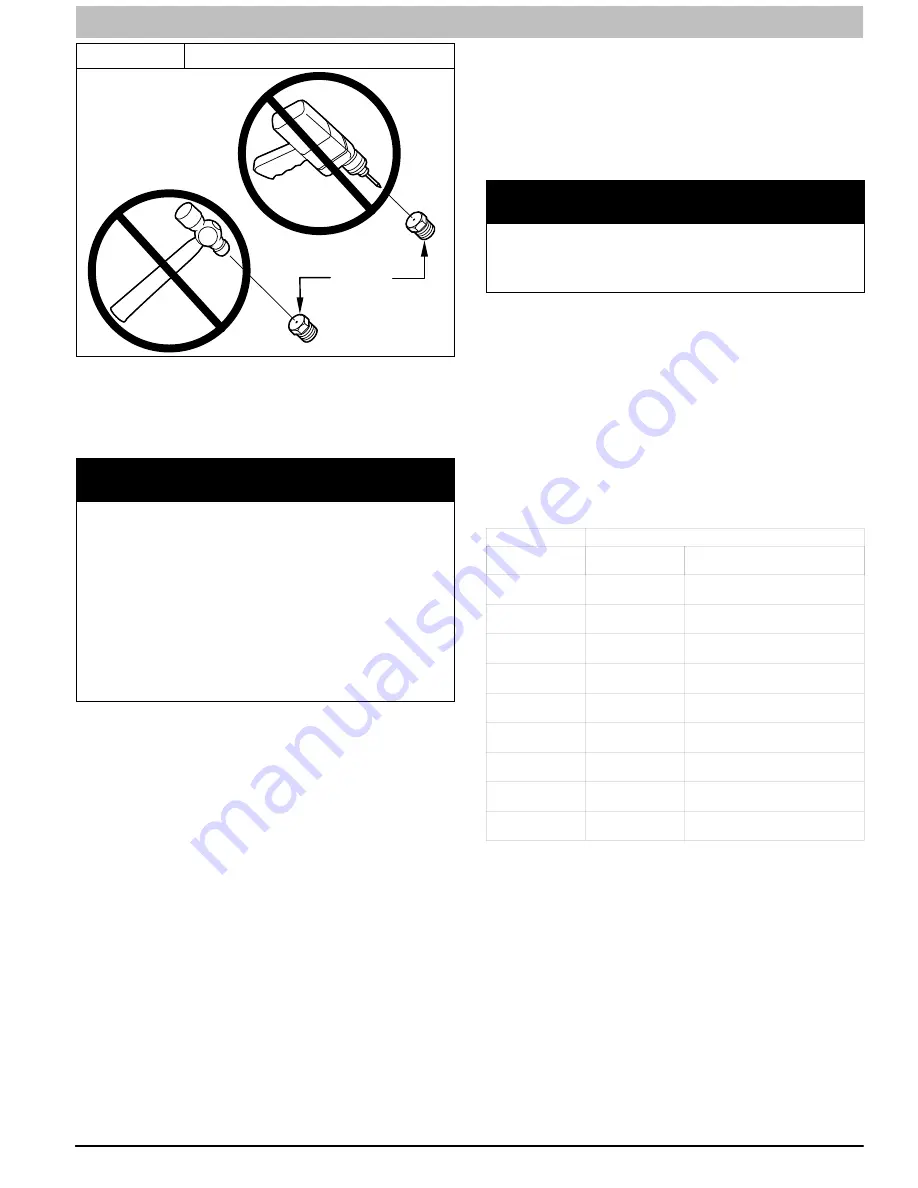
SERVICE AND TECHNICAL SUPPORT MANUAL
Gas Furnace: N9MSE
Specifications subject to change without notice.
440 04 4401 03
5
Figure 2
Orifice Hole
A93059
BURNER
ORIFICE
For proper operation and long term reliability the furnace input
rate must be /
−
2 percent of input rate on furnace rating
plate, or as adjusted for altitude.
The gas input rate on rating plate is for installation at altitudes
up to 2000 ft. (610 M).
NOTICE
The NATURAL GAS manifold pressure adjustments in
Table 3
compensate for BOTH altitude AND gas heating value. DO
NOT apply an additional de
−
rate factor to the pressures shown
in
Table 3
. The values in this Table and NOT referenced to sea
level; they are AS
−
MEASURED AT ALTITUDE.
The heating content of natural gas at altitude may already
provide for a reduction in capacity or altitude. Refer to
Table 3
.
No adjustments to the furnace may be necessary at altitude for
certain gas heating values.
Refer to the instructions provided in the factory-specified
LP/Propane conversion kit for instructions for setting gas
manifold pressures for LP/Propane applications.
In the USA, the input rating for altitudes above 2000 ft. (610 M)
must be reduced by 2 percent for each 1000 ft. (305 M) above
sea level refer to
Table 1
. The natural gas manifold pressures
in
Table 3
adjust for BOTH altitude and natural gas heating
value.
In Canada, the input rating must be reduced by 5 percent for
altitudes of 2000 ft. to 4500 ft. (610 to 1372 M) above sea level.
The natural gas manifold pressures in
Table 3
adjust for BOTH
altitude and natural gas heating value.
NOTE
: For Canadian altitudes of 2000 to 4500 ft. (610 to 1372
M), use USA altitudes of 2001 to 3000 ft. (611 to 914 M) in
Table 3
.
To adjust manifold pressure to obtain the proper input rate, first,
determine if the furnace has the correct orifice installed. At
higher altitudes or different gas heat contents, it may be
necessary to change the factory orifice to a different orifice.
Tables have been provided in the furnace Service and
Technical Manual to match the required orifice to the manifold
pressure to the heat content and specific gravity of the gas. To
do this:
1. Obtain average yearly gas heat value (at installed
altitude) from local gas supplier.
2. Obtain average yearly gas specific gravity from local gas
supplier.
3. Find installation altitude range for your installation in the
manifold pressure tables in
Table 3
.
4. Find closest natural gas heat value and specific gravity in
Table 3
. Follow heat value and specific gravity lines to
point of intersection to find orifice size and low-and
high-heat manifold pressure settings for proper
operation.
5. Check and verify burner orifice size in furnace. NEVER
ASSUME ORIFICE SIZE. ALWAYS CHECK AND
VERIFY.
NOTICE
If orifice hole appears damaged or it is suspected to have been
redrilled, check orifice hole with a numbered drill bit of correct
size. Never redrill an orifice. A burr
−
free and squarely aligned
orifice hole is essential for proper flame characteristics.
6. Replace orifice with correct size, if required by
Table 3
.
Use only factory
−
supplied orifices. See EXAMPLE 1.
EXAMPLE 1:
0 - 2000 ft. (0 - 609.6M) altitude
Heating value = 1050 Btu/cu ft.
Specific gravity = 0.62
Therefore: Orifice No. 44
(Furnace is shipped with No. 44 orifices. In this example, all
main burner orifices are the correct size and do not need to be
changed to obtain proper input rate.)
Manifold pressure: 3.4-in. w.c. (847 Pa).
NOTE
: To convert gas manifold Table pressures to Pascals,
multiply the in.w.c. value by 249.1 Pa/in. w.c. (1 in. wc. = 249.1
Pa).
Table 1
Altitude Derate Multiplier for USA
ALTITUDE
FT. (M)
PERCENT
OF DERATE
DERATE MULTIPLIER
FACTOR*
0–2000
(0
−
610)
0
1.00
2001–3000
(610
−
914)
4
−
6
0.95
3001–4000
(914
−
1219)
6
−
8
0.93
4001–5000
(1219
−
1524)
8
−
10
0.91
5001–6000
(1524
−
1829)
10
−
12
0.89
6001–7000
(1829
−
2134)
12
−
14
0.87
7001–8000
(2134
−
2438)
14
−
16
0.85
8001–9000
(2438
−
2743)
16
−
18
0.83
9001–10,000
(2743
−
3048)
18
−
20
0.81
* Derate multiplier factors are based on midpoint altitude for altitude range.
NOTE
:
For Canadian altitudes of 2000 to 4500 ft. (610 to
1372 M), use USA altitudes of 2001 to 3000 ft. (610 to 914
M)
Check Inlet Gas Pressure
The inlet gas pressure must be checked with the furnace
operating in maximum heat. This is necessary to make sure the
inlet gas pressure does not fall below the minimum pressure of
4.5 in. w.c.
1. Make sure the gas supply is turned off to the furnace and
at the electric switch on the gas valve.
2. Remove the 1/8 in. NPT plug from the inlet pressure tap
on the gas valve.
3. Connect a manometer to the inlet pressure tap on gas
valve.
4. Turn on furnace power supply.


































![Roberts Gorden Combat UHD[S] 150-400 Specifications preview](http://thumbs.mh-extra.com/thumbs/roberts-gorden/combat-uhd-s-150-400/combat-uhd-s-150-400_specifications_1469644-1.webp)



